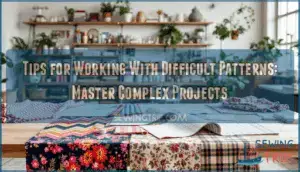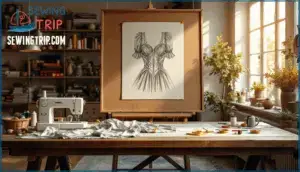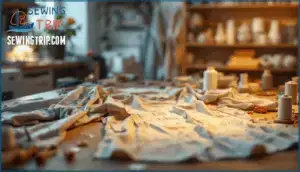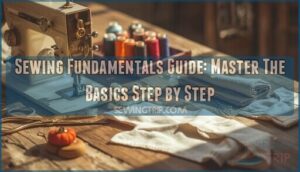This site is supported by our readers. We may earn a commission, at no cost to you, if you purchase through links.

The difference between a project that wows and one that frustrates often comes down to knowing which challenges you’re facing and having the right strategies to tackle them. When you can spot the tricky bits before you start and apply proven techniques throughout construction, those intimidating patterns become totally manageable.
Table Of Contents
Key Takeaways
- Before you cut, identify whether your pattern is geometric, organic, or mixed—this helps you anticipate construction challenges and plan seam placement strategically before mistakes happen.
- Matching patterns at seams requires measuring both vertical and horizontal repeats ahead of time, pinning fabric at key intersections, and checking alignment from both sides to avoid that "close but not quite" heartbreak.
- Keep lifelines or basting stitches as safety nets throughout construction—they’ll save you hours of unraveling when you’re deep into complex work and something goes sideways.
- Pre-washing patterned fabric prevents shrinkage and color bleeding disasters, while smart layout techniques like nesting smaller pieces between larger ones minimize waste and maximize your yardage.
Identifying Challenging Pattern Elements
Before you tackle a tricky pattern, you need to know what makes it difficult in the first place. The real challenge isn’t just following instructions—it’s spotting the curve balls before they trip you up.
Here’s what to watch for as you size up your next project.
Recognizing Complex Shapes and Motifs
Complex shape recognition is your first line of defense when tackling tricky patterns. You’ll need to classify what you’re seeing—geometric shapes like chevrons and quatrefoils, or organic florals and abstract motifs—before you can plan your approach. Here’s what to watch for:
- Geometric shapes: Look for repeating angles, symmetry, and structured elements like stripes or houndstooth
- Organic shapes: Identify flowing florals, irregular curves, and nature-inspired motifs that lack rigid structure
- Mixed motifs: Spot where geometric and organic shapes combine, creating layered visual complexity
- Pattern geometry: Assess how shapes interact, overlap, or create secondary motifs across the fabric
Mastering motif detection helps you anticipate construction challenges and plan seam placement strategically.
Understanding fabric pattern types is essential for working with complex designs.
Spotting Scale and Proportion Issues
Once you’ve identified the shapes in your pattern, scale and proportion become your next hurdle. Garments with mis-scaled proportions show up to 27% more visible fit flaws at seams and darts—that’s why spotting uneven grade increments early saves headaches later.
Scale and proportion flaws cause 27% more visible fit issues, so catch uneven grade increments before you cut
Pay attention to how large and small pattern elements balance across your fabric. Pattern distortion becomes significant after three size grades from your sample pattern, so fit analysis and careful scale adjustment matter whether you’re using digital grading tools or traditional pattern making methods.
Working with patterns demands a sharp eye for proportion errors before you cut. Utilizing digital pattern grading techniques can help minimize these issues.
Assessing Color Combinations and Contrasts
Beyond proportion, color harmony and contrast theory can make or break your pattern. High lightness contrast boosts perceived harmony by roughly 10%, while saturated color pairings feel disharmonious in over 60% of cases. Before you commit, try these steps:
- Convert your pattern to grayscale—75% of professionals use this trick to check pattern legibility and value contrast.
- Squint-test your fabric to see if colors blend or pop distinctly.
- Pair similar hues for smoother visual perception (up to 24% higher preference ratings).
- Cool tones like blues and greens score over 70% better for harmony than warm combos.
Working with patterns means smart color theory beats guesswork every time.
Analyzing Fabric Grain and Seam Placement
Once you nail your colors, the real detective work starts—tracking down where those grain lines run and hunting for hidden seams that can make or break your pattern match. Patterned fabric reveals clues about fabric flow—stripes show grain line instantly, while florals hide seam alignment challenges. Study reference photos to spot where seams hit motifs, then mark your fabric pieces before cutting.
Smart pattern making means respecting that grain line—it’s your roadmap for professional seam alignment.
| Element | What to Check | Why It Matters |
|---|---|---|
| Grain Line | Arrows on pattern pieces | Controls fabric flow and drape in garment construction |
| Seam Placement | Where pattern pieces meet | Affects pattern matching at joins |
| Fabric Weave | Crosswise vs. lengthwise threads | Determines stretch and stability |
| Motif Direction | Print alignment with grain | Creates visual harmony or chaos |
| Dart Locations | Pattern markings on curves | Influences how motifs distort or align |
Preparing Tools and Materials for Success
The right setup can make or break a challenging pattern project. Before you cut a single piece or cast on your first stitch, you need to gather quality materials and organize your space strategically.
Let’s walk through the essentials that’ll set you up for success from the start.
Choosing Appropriate Fabrics or Yarns
The fabric or yarn you choose is the foundation of your entire project—get this wrong, and even the best technique won’t save you. For complex patterns, fiber choice and yarn weight matter more than ever. Here’s what to keep in mind:
- Heavy fabrics like canvas or worsted yarn support large-scale patterns without distortion
- Lightweight materials such as cotton lawn or laceweight yarn showcase intricate details beautifully
- Texture mixing adds dimension—try pairing smooth silk with nubby linen for visual contrast
- Color palette should complement your pattern repeats, not fight them
Selecting The Right Needles or Sewing Tools
Your needles and tools aren’t just accessories—they’re the difference between wrestling with your work and gliding through it. Quality stainless steel needles glide through tight stitches, while sharp fabric shears prevent fraying during garment construction.
For intricate pattern making, invest in interchangeable circular needles and precision sewing notions like fine pins.
Proper tool maintenance and smart equipment choices transform sewing techniques from frustrating to fluid, letting you focus on textile arts instead of fighting your materials.
Organizing Workspace for Efficiency
A cluttered workspace is like trying to solve a puzzle with half the pieces buried under yesterday’s coffee cup—you’ll waste more time hunting than creating. Workspace optimization starts with smart tool storage—clear bins for notions, labeled drawers for pattern pieces, and an ergonomic setup that keeps your back happy.
Supply management and productivity tips turn chaos into control, so you’re always ready for intricate garment construction without the frantic search.
Using Style Sheets for Pattern Consistency
When you’re juggling florals, stripes, and geometric prints across a single project, a style sheet becomes your secret weapon for keeping everything intentional instead of accidental.
This simple template acts as your design standards reference—documenting which pattern templates go where, your formatting rules for repeats, and consistency checks to prevent that "what was I thinking?" moment when you’ve mixed scales that clash instead of complement.
Mastering Pattern Layout and Cutting
Getting your layout and cutting right can make or break a tricky pattern project.
When you’re working with complex motifs or repeating designs, a few smart strategies will save you headaches down the road.
Here’s what you need to focus on to set yourself up for success.
Aligning Grain Lines and Motifs Accurately
Getting your grain lines straight is like finding true north on a compass—mess that up, and everything else starts to wander off course. When you’re working with patterns, fabric orientation matters because it controls drape and stability. Before cutting, mark your grain line management points and pin motif alignment carefully so everything flows in the right direction.
Here’s what you need to focus on:
- Check your fabric’s selvage edge – that’s your anchor for pattern making and keeps seam accuracy sharp
- Pin motifs at key intersections – matching florals or stripes prevents that "close but not quite" heartbreak
- Use a ruler for grain line verification – eyeballing leads to crooked sewing techniques and wonky results
Pattern matching starts here, so take your time with fabric orientation.
Matching Pattern Repeats at Seams
If you think lining up patterns is hard, matching them where two pieces meet is where most projects go from "handmade" to "homemade disaster." Seam alignment demands careful repeat management—measure your pattern’s vertical and horizontal repeats before cutting.
Pin fabric placement at intersections, then check both sides to confirm your pattern matching holds true.
Edge finishing reveals whether you nailed garment construction or need more practice with sewing techniques and tips for pattern making success.
Using Reference Photos for Detail Placement
Once your seams align, reference photos become your blueprint for placing every pleat, dart, and decorative detail exactly where they belong. Visual inspection reveals pattern clues—grain lines, seam locations, and fabric flow—that guide detail mapping.
Study your reference guides closely, examining how fashion pattern making translates into garment construction techniques. This photo analysis sharpens your working with patterns skills, turning guesswork into precision when applying sewing techniques and tips.
Marking and Notching for Precision
Precision marking and notching turn those photo insights into permanent guideposts on your fabric, so you don’t lose your place mid-construction. Notch placement and precision marking lock in pattern alignment before you even start stitching. Here’s how to nail seam accuracy:
- Mark darts and pleats with tailor’s chalk or washable pens
- Notch seam allowances at match points for pattern making precision
- Double-check grain lines to maintain garment construction integrity
These cutting techniques keep your sewing patterns and textile arts projects on track.
Applying Techniques for Complex Construction
Once you’ve got your pattern pieces ready, the real work begins—putting it all together without losing your mind. Complex construction means knowing how to manage tricky details, balance visual elements, and build in safety nets for when things go sideways.
Here’s how to tackle the tough stuff with confidence.
Managing Tricky Seams and Darts
You’ll master tricky seam finishing and dart placement with the right techniques. When working with thick fabrics, trim contour dart excess to just 1.2 cm to avoid bulk. Clip horizontally at the dart’s midpoint for flexibility, stopping 0.6 cm from your stitch line. For bust darts, end them 2.5–3 cm before the bust point, then press toward the garment center.
Your pattern accuracy improves when you taper stitches at dart ends and use a pressing ham for curved darts. These sewing techniques transform garment construction from frustrating to professional, giving you control over even the most challenging pattern-making projects.
| Challenge | Solution |
|---|---|
| Puckering at dart ends | Sew with a gradual angle; tie off threads instead of backstitching |
| Overly pointy darts | Shorten dart length by 1–2 cm for smoother shaping |
| Excess bulk in seams | Use zigzag or serging on high-fraying fabrics; trim before stitching |
Balancing Large and Small Pattern Elements
After you’ve conquered those seams and darts, the next challenge is mixing bold florals with delicate stripes—or pairing an oversized geometric print with tiny polka dots—without making your project look like a visual circus.
Working with patterns means establishing visual hierarchy through contrast theory and element proportion. Anchor your design with one large-scale focal point, then layer smaller repeats around it.
Design harmony happens when you balance scale with repetition—think of it like conducting an orchestra where every instrument knows its role.
Using Lifelines or Basting for Corrections
Mistakes happen fast—especially when you’re wrist-deep in a complex pattern—but a simple lifeline or basting stitch can save hours of unraveling and redo work. These correction strategies act like safety nets for your project:
- Thread lifelines through live stitches in knitting patterns every few rows
- Use contrasting thread for basting techniques so you can spot it instantly
- Mark your progress points before attempting complex knitting patterns
- Keep lifeline management tools (thin yarn, dental floss) in your kit
- Practice stitch recovery on scrap fabric to build confidence
Pattern mixing and sewing basics become less intimidating when you’ve got a backup plan woven right into your work.
Incorporating Repetition and Contrast Effectively
The rhythm of your pattern—how elements echo and clash—transforms a flat design into something that pulls the eye across every inch of fabric. Repetition techniques anchor your design principles, while contrast elements create focal points that prevent visual fatigue.
Balance large florals with tight geometric repeats, or pair bold stripes against delicate motifs. Pattern mixing works when you let one element dominate and the others support it—that’s pattern harmony in action.
Troubleshooting and Refining Finished Projects
Even the best work needs a second look—and sometimes a few fixes. Once your project’s complete, you’ll want to spot any pattern mismatches, tweak the fit, and add those finishing touches that make everything look intentional.
Here’s how to troubleshoot like a pro and turn good work into something you’re genuinely proud of.
Fixing Misaligned Patterns or Motifs
When a pattern goes rogue and motifs don’t line up the way you planned, don’t panic—most misalignments can be fixed with a few smart tweaks. Check your seams first—sometimes a quarter-inch adjustment in seam correction makes all the difference in fabric matching.
If you’re working with patterns that have repeats, unpick the troublesome section and realign before restitching. For motif adjustment, pin carefully and use your reference photos to guide placement, securing visual balance across the entire piece.
Adjusting for Fit and Visual Balance
Fit isn’t just about measurements—it’s about making your pattern feel right in both how it wears and how it looks. Step back and check proportion control—does one section overwhelm another?
Use symmetry analysis to spot uneven elements, then adjust seams or darts to restore visual harmony. Balance techniques like redistributing pattern weight or tweaking focal points create visual balance that transforms a good project into a showstopper.
Blocking or Pressing for a Polished Look
Your project’s almost there—now it’s time to block or press it into its best self. Finishing techniques like steaming methods or fabric relaxation smooth out wonky seams and let your pattern design shine.
Use the right pressing tools—steam for knits, dry heat for wovens—and watch your sewing techniques pay off. These polishing strategies transform homemade into handcrafted, giving you that crisp, professional edge.
Learning From Mistakes for Future Projects
Every misstep teaches something if you capture it. Mistake logging turns chaos into clarity—think of it as your pattern’s blueprint for next time. Here’s how to utilize error analysis for iterative learning:
- Keep a project journal documenting what went sideways and why—42% of crafters swear by dedicated error logs for future reference.
- Build feedback loops through peer reviews or post-project check-ins to catch patterns you’d miss solo.
- Apply corrective actions immediately—76% of makers intentionally modify workflows after analyzing their mistakes, leading to smoother projects ahead.
When you embrace iterative learning in working with patterns, those complex knitting patterns and sewing techniques become less intimidating with each attempt.
Frequently Asked Questions (FAQs)
How do I prevent fabric from shifting during cutting?
Use fabric stabilization techniques like pattern weights on cutting mats to anchor your material. Rotary cutters glide smoothly without lifting fabric, while proper grain line alignment and interfacing techniques prevent shifting.
Pin strategically along seam lines when working with slippery fabrics in any sewing class.
Whats the best way to handle directional prints?
Directional prints follow a one-way path, like arrows guiding the eye. Always identify print orientation before cutting—lay all pattern pieces in the same direction. This prevents upside-down motifs and maintains symmetry balance.
Though fabric selection costs more yardage, proper directional placement guarantees textile design harmony through repetition and contrast without weaving confusion.
Should I pre-wash patterned fabrics before starting?
Yes, absolutely pre-wash your patterned fabric. Fabric shrinkage and color bleeding can wreck your project, so pre-wash benefits include preventing texture changes.
This fabric preparation step locks in your pattern before you cut, guaranteeing sewing techniques work with stable textile dimensions.
How can I minimize pattern waste on fabric?
Smart fabric cutting starts with a few key moves. Lay out all pattern pieces first to visualize the best arrangement—you’ll spot opportunities to nestle smaller pieces between larger ones.
Use fabric width efficiently by aligning grain lines parallel to selvage, and consider directional prints carefully.
Fold strategically so you’re cutting multiple layers when possible, and save every scrap for future piecing or small accent work.
Conclusion
Picture that chevron lining up perfectly, those plaids intersecting exactly where they should—that’s the payoff when you master tips for working with difficult patterns.
Each technique you’ve learned becomes muscle memory, turning what once felt impossible into your new standard.
The next time you face a challenging design, you won’t hesitate. You’ll cut with confidence, stitch with precision, and finish with pride because complex patterns don’t intimidate you anymore—they inspire you.
- https://www.vogue.co.uk/fashion/spring-summer-2008/couture/valentino/full-length-photos/gallery/271297
- http://fashiontribes.typepad.com/fashion/2008/09/a-luscious-coff.html
- https://www.hachettebookgroup.com/titles/kristina-mcgrath/the-knitting-pattern-writing-handbook/9781635866247/
- https://pmc.ncbi.nlm.nih.gov/articles/PMC10435961/
- https://arxiv.org/html/2405.17609v1













